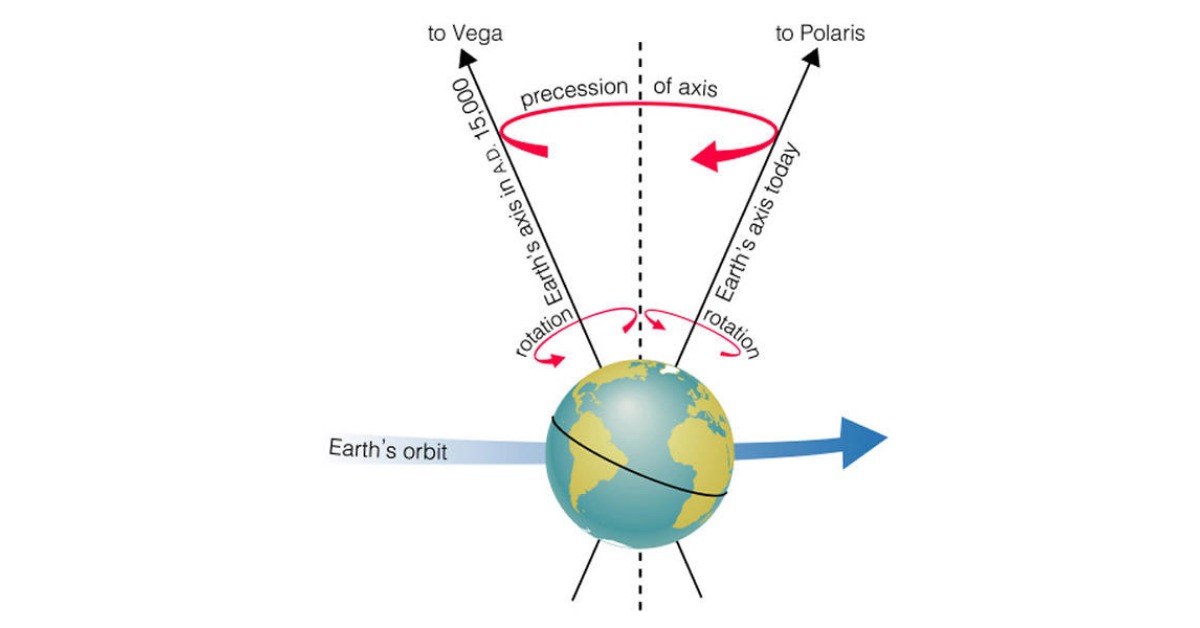Earth’s tilting motion, causes the pole star’s position to change in the sky. (Precession motion of Earth and relative change of the pole star position in the sky)
Earth's acceleration
We have been hearing since mythological times that the Pole Star is fixed, right? But Dhruva Star is apparently steady in a human lifetime because the Earth’s rotational axis is pointed towards the star, so that star seems to be steady in the sky for 24 hours a day and other stars, planets, constellations are seen rising in the east direction and setting in the west direction.
But due to the precession motion of the earth, the pole star also changes every few thousand years.

Imagine the earth spinning around itself like a spinning toy top, the top of the vortex will be the first to take small circular turns as it slows down. This type of rotation is called paranchan gati.
The Earth’s axis is inclined at about 23.5 degrees, which points towards the current pole star, Polaris (Polaris – current pole star). This tilted axis, due to its rotational motion, creates a very large circle in the sky around which many different constellations and prominent stars appear. When the axis is inclined towards a particular Nakshatra or star, that star is known as the pole star of that time.
Approximately every 72 years, this inclined axis appears to move around the circumference of a circle in the sky at an angle of 1 degree. It completes 1 round after about 26000 years.

In the year 2787 BC, the star “Thuban” (Thuban) was known as the pole star of the earth, at that time the people who built the pyramids in Egypt recorded it.
Looking further into the future, in 4000 AD, Gamma Cephei, aka Errai, will become a pole star.
Then in 7500 AD “Alpha Cephei, also known as Alderamin” will be the pole star.
About 12,000 years from today, “Vega” – Abhijit (Vega – Alpha Lyrae) will become a pole star.
Thus this cycle continues to rotate in the direction of certain stars every 26000 years giving them the name Pole Star.
And Possibly something similar to erupting prominence as happened recently
As the Earth rotates around itself, the gravitational force of both the Sun and the Moon acts on it. Due to this, the equatorial bulge of the earth is pulled a little and the polar part shrinks due to the opposing forces, the earth’s axis gets tilted in addition to the rotation of the earth. And so the tilt of the Earth’s axis, as mentioned above, makes a virtual circle in the sky and identifies the prominent stars that come upon it as the Pole Star after certain years.
Another major change that occurs on Earth due to planetary motion is the reversal of Earth’s seasonal cycles. (Shit in seasonal cycles in hemispheres)
As we see now it rains from June to September, October-January is cold, February-May is summer in Northern Hemisphere as opposed to Southern Hemisphere. But as the inclined axis of the earth moves forward in the circular motion of the space formed by the motion of the planet, this seasonal cycle reverses after a few thousand years and we will see that the rainy season will be in January-April, summer in September-December, cold in May-August.

Is it fun or not?
This has happened many times in the history of the earth, but since the current chronology started only 2000 years ago, the records of the seasons have been recorded by the people of different cultures according to their chronology.
